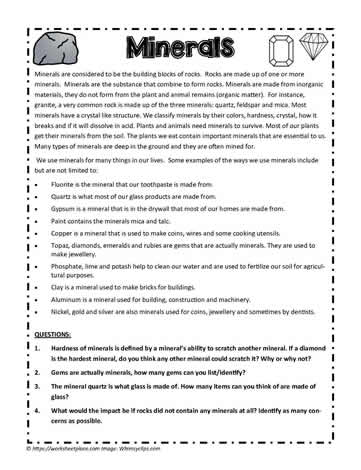| |||||
| Mineral Comprehension Activity For Google Apps | |||||
| Lessons for teaching rocks and minerals. An activity to discover what a mineral is and how we use them in our everyday life. Minerals are considered to be the building blocks of rocks. Rocks are made up of one or more minerals. Minerals are the substance that combine to form rocks. Minerals are made from inorganic materials, they do not form from the plant and animal remains (organic matter). For instance, granite, a very common rock is made up of the three minerals: quartz, feldspar and mica. Most minerals have a crystal like structure. We classify minerals by their colors, hardness, crystal, how it breaks and if it will dissolve in acid. Plants and animals need minerals to survive. Most of our plants get their minerals from the soil. The plants we eat contain important minerals that are essential to us. We use minerals for many things in our lives. Some examples of the ways we use minerals include but are not limited to: • Fluorite is the mineral that our toothpaste is made from. • Quartz is what most of our glass products are made from. • Gypsum is a mineral that is in the drywall that most of our homes are made from. • Paint contains the minerals mica and talc. • Copper is a mineral that is used to make coins, wires and some cooking utensils. • Topaz, diamonds, emeralds and rubies are gems that are actually minerals. They are used to make jewellery. • Phosphate, lime and potash help to clean our water and are used to fertilize our soil for agricultural purposes. • Clay is a mineral used to make bricks for buildings. • Aluminum is a mineral used for building, construction and machinery. • Nickel, gold and silver are also minerals used for coins, jewellery and sometimes by dentists. QUESTIONS: 1. Hardness of minerals is defined by a mineral’s ability to scratch another mineral. If a diamond is the hardest mineral, do you think any other mineral could scratch it? Why or why not? 2. Gems are actually minerals, how many gems can you list/identify? 3. The mineral quartz is what glass is made of. How many items can you think of are made of glass? 4. What would the impact be if rocks did not contain any minerals at all? Identify as many concerns as possible. | |||||

All worksheets are created by experienced and qualified teachers. Send your suggestions or comments.